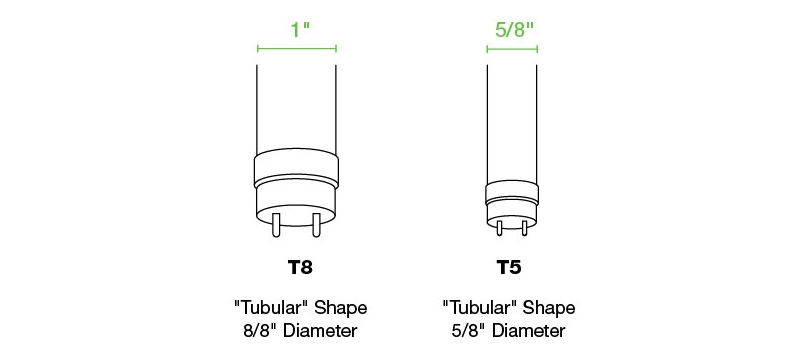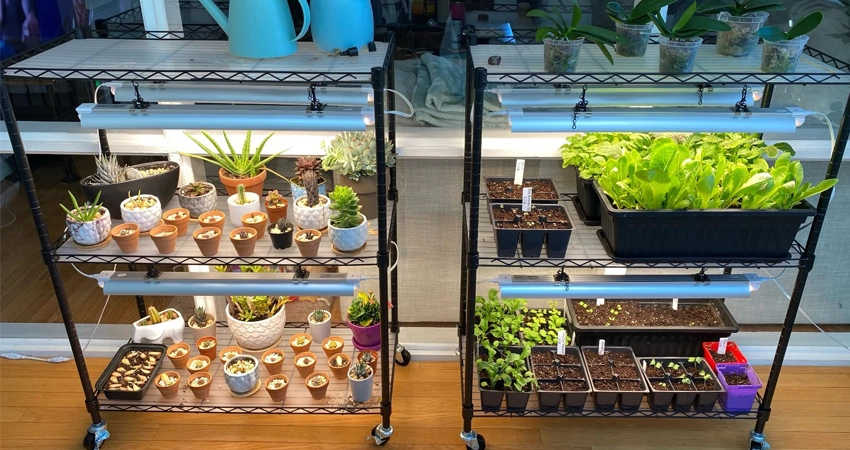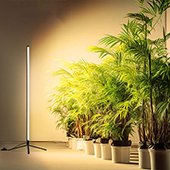Menu
What is the Difference Between T5 and T8 Grow Lights?
In the vibrant world of hydroponics, plants thrive under artificial light, and choosing the right LED plant lights can make all the difference.
The T5 and T8 grow lights, designed specifically for plants, stand out as the two most noteworthy options.
However, before you opt for these luminous contenders, let’s analyze their differences to find the plant light fixture that suits your needs best.
Table of Contents
Difference Between T5 and T8 Grow Lights
Difference in Size
The “T” in their names isn’t just a fancy flourish! It stands for “tube” and reveals a crucial secret: the diameter of the lamp is eighths of an inch.
T5 grow light tubes boast a slender frame of 5/8 of an inch, while T8 grow light tubes strut their stuff with a sturdier 1-inch diameter.
The slim and sleek T5 tubes are ideal for space-constrained setups where every inch counts.
These robust T8 tubes fill larger spaces with their radiant glow, and sprawling greenhouses or multi-tiered hydroponic gardens.

Performance Powerhouse
When it comes to harnessing the vibrant energy of artificial sunlight for indoor gardens, lumens per watt (lm/W) is the efficiency battle cry – indicating how much light is produced per watt of electrical input into LED tubes.
In this realm, T5 LEDs outperform T8 LEDs in lumens per watt, meaning they provide more light while consuming less energy.
Let’s break down the numbers:
T5 tube grow lights typically boast lm/W values ranging from 120 to 160, meaning they can produce 120 to 160 lumens of light for every watt of electricity.
T8 LED tubes usually hover around the 80 to 110 lm/W range, delivering less light per watt compared to their T5 counterparts.
This might seem like a small difference, but over time, it translates to significant energy savings, especially for large-scale hydroponic setups or dedicated plant rooms.
Consider this: if you need 10,000 lumens to illuminate your verdant kingdom, you’d only need around 63 T5 LED grow tube lights compared to 91 T8 LEDs to achieve the same light intensity. That’s 28 fewer tubes and potentially a hefty reduction in your electricity bill!
The smaller size of T5 LEDs also plays a role in their efficiency. Thanks to their compact 5/8-inch diameter, they can be packed closer together in fixtures, concentrating more light in a smaller area.
This allows you to achieve the desired light intensity with fewer T5 LED tubes compared to bulkier T8 tube grow lights, further reducing energy consumption and potentially freeing up valuable space in your grow room.
The focused light output of T5 LEDs can also benefit your plants directly. By delivering denser light within a specific area, you can create targeted zones for different growth stages or plant varieties, optimizing photosynthesis and potentially boosting yields.
Spectrum and Plant Growth
T5 and T8 grow light tubes offer unique spectral melodies, each influencing your leafy performers in distinct ways.
T5 vertical grow light tube: They offer a wide range of spectral options to cater to different plant needs. They come in full-spectrum options that mimic natural sunlight, delivering a balanced blend of blue, green, red, and other wavelengths essential for photosynthesis and overall plant health.
T8 vertical grow light tube: They tend to focus on specific portions of the spectrum, often excelling in blue and red light regions. This makes them well-suited for promoting specific growth stages, like blue light for vegetative growth and red light for flowering and fruiting.
Life and Maintenance
Durability
T5 LEDs: Think of them as endurance athletes, boasting lifespans of 50,000 to 70,000 hours, sometimes even reaching 100,000 hours with proper care. That’s roughly 5 to 7 years of continuous operation, lighting your plants through countless growth cycles without needing replacements.
T8 LEDs: While not slouches in the longevity department, they generally lag behind their T5 counterparts. Expect lifespans of 30,000 to 50,000 hours, translating to 3 to 5 years of luminous service. Still impressive, but it might require more frequent tube replacements compared to T5s.
Daily Cleaning
T5 LEDs: Their slim profile means less surface area for dust to accumulate, and a quick wipe with a damp cloth every few months is enough to keep them shiny.
T8 LEDs: Their larger diameter may attract more dust, but they are relatively easy to maintain. An occasional wipe with a damp cloth is sufficient.
Application Suggestions
While both T5 and T8 LED plant light tubes can provide powerful illumination, their performance differences determine who shines the brightest in specific scenarios.
T5 LEDs: Efficiency at its Peak
Compact in size, they are perfect for space-constrained areas like tents or shelves. Miniature greens, herbs, or compact leafy plants can thrive under the comfortable glow.
If your plants prefer gentle lighting, T5 is the ideal companion. With lower light intensity, they are well-suited for delicate seedlings or shade-loving varieties like orchids and ferns.

T8 LEDs: Power at its Peak
Need lighting for larger planting spaces like greenhouses or multi-tiered gardens? T8 LEDs boast higher overall light output, bathing expansive planting areas in vibrant growth light.
Compared to T5, T8 often comes with a lower upfront cost, making it a budget-friendly choice for large-scale growers or those venturing into hydroponics for the first time.
For plants with moderate light requirements, T8 can provide ample illumination. Consider fruits and vegetables, some flowering plants, or leafy greens that thrive even in slightly brighter conditions.

Cost Comparison
Briefly compare the initial and long-term costs of T5 and T8 grow lights.
Initial Investment
T5 LED: Be prepared for a potentially higher upfront investment. They are more efficient, have a longer lifespan, and come with a higher price tag compared to T8.
T8 LED: These products often have a lower initial budget, making them attractive to cost-conscious growers or those just starting with hydroponics.
Long-term Savings
T5 LED: While the initial cost may be higher, in the long run, their lower energy consumption can result in significant savings on electricity bills, especially for larger setups.
T8 LED: Despite the more affordable upfront price, over time, their higher energy consumption might save you less. However, compared to traditional fluorescent lights, they still offer substantial energy savings.
Replacement Costs
T5 LED: With a longer lifespan (50,000-100,000 hours), they require fewer replacements, reducing long-term costs.
T8 LED: With a lifespan of 30,000-50,000 hours, you may need to replace bulbs earlier compared to T5, increasing the overall cost.
This is just a cost focal point, not a comprehensive financial overview. Several factors impact the overall situation, including:
Setup Size: Larger setups benefit more from T5’s long-term energy efficiency.
Electricity Rates: Higher rates can amplify the impact of T5’s energy-saving efficiency.
Usage Frequency: Continuous operation highlights the cost advantage of T5.
Conclusion
Remember, choosing the right LED tubes depends on your specific needs and priorities.
While T5 grow light tubes reign supreme in efficiency and light concentration, T8 tube grow lights might be more budget-friendly.
Choosing the right LED grow light requires balancing initial investment with long-term savings. While T5s might win the efficiency award, T8s offer budget-friendly entry into the hydroponic world.
Weigh your options, assess your needs, and let the power of LED technology guide you toward a thriving, illuminated garden!
Get in touch with us!
From custom light planning, to tailored quotes, and everything in between, our team of horticulture experts are always ready to assist.




